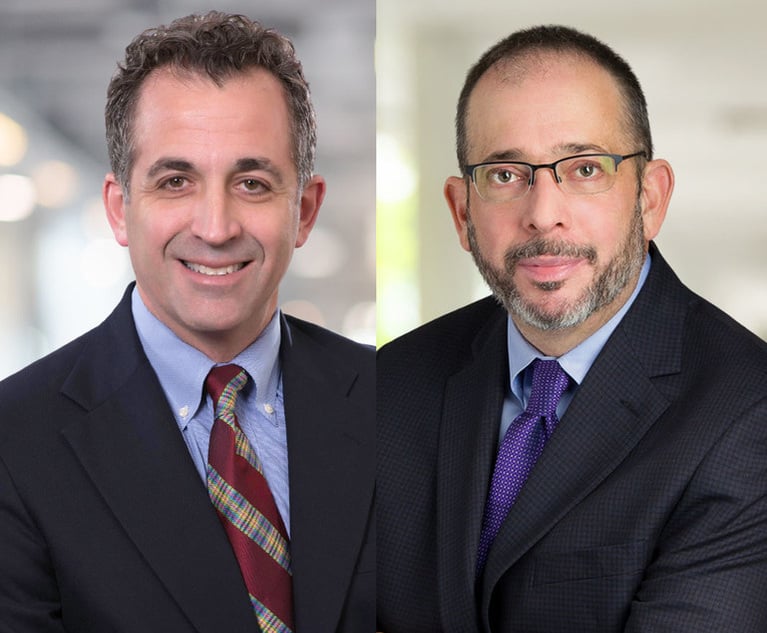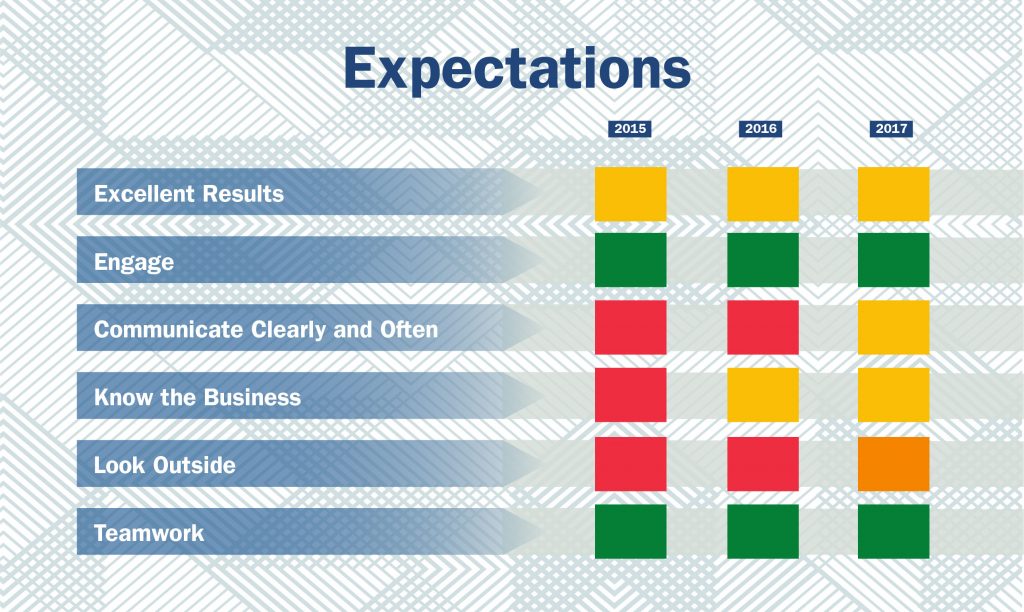Michelin's Former and Current GCs Offer a Lawyer's Guide on Expectations
The best way to achieve a goal is to set it. The same is true for expectations. Be simple, clear, and direct. And be candid and constructively self-critical in the assessment.
May 07, 2018 at 06:06 PM
7 minute read
 (Photo: Shutterstock.com)
(Photo: Shutterstock.com)
It is no secret that our own George Washington and France's Marquis de Lafayette were dear friends. One of the many reasons for this friendship is attributed to Lafayette's introducing himself to Washington by saying, unlike other French leaders before him, “I am here to learn, not teach.” In this spirit, we are not writing this article to teach anything. Our intent is simply to share a technique we used in recent years to help us communicate and perform. We found it easy and effective. Our hope is that you might find something useful in it, take it, improve upon it and return it in a forum, like this or elsewhere, so that we all continue to learn.
Expectations
A quotation credited to Michelangelo is, “The greater danger for most of us lies not in setting our aim so high that we miss it, but in setting our aim so low that we reach it.”
Here's a simple challenge: ask three lawyers with whom you work to describe the core of their jobs—what they are responsible to accomplish. Whether in-house or private practice, you might be surprised to learn how inconsistently those around you answer the simple question: what is expected? Associates at a private law firm might quote billable or collection goals, while in-house counsel might regurgitate a legal department quality statement or slogan.
Worse yet, you may get a blank stare.
An easy, practical way to work well as a team is to set clear expectations. This is true for real people, and even for lawyers.
In Michelin's legal department, the expectations we set for the internal staff were simple individually but lofty in the collective. After a few revisions and several test runs, we ended up with the following list:
- Excellent results
- Engage
- Communicate clearly and often
- Know the business
- Look outside
- Teamwork
Realizing that lawyers are always debating and that more specificity is better than less, we went a step further and defined each one in the context of a variety of practice areas:
Excellent Results
Outputs that move the business forward are actually realized (as distinguished from effort); resources are aligned to high risk/strategic areas; problems/risks are identified and corrected before impact (proactive vs. reactive).
- Deals are closed / Patents are filed
- Trials and motions are won
- Contracts are signed (on our terms)
- Risk is defined, audited and corrected
- Process improvements are implemented and routinely tested
Engage
Visible, positive action to further department and company interests; active participation and interest in the work of your colleagues.
- Participative attendance at scheduled meetings
- “Tension” in the system—differing viewpoints are offered and debated
- New practices/improvements/recommendations are suggested outside your area of direct responsibility
Communicate Clearly and Often
Information flows vertically and horizontally; it is clear, concise and regularized; it is effective – audience leaves with an understanding of important points; the “message” is intentional; communications are visible and tangible—documented and shared with other stakeholders.
- Publication of a standard report on an established schedule
- Visibility of reporting to your management and your teammates
- High-level information with recommendations offered directly to senior client management
- Recommendations are in writing
- Surprises are avoided
Know the Business
General knowledge of industry and competitors, and solid working knowledge of your clients' business and goals.
- You keep awareness of industry developments and media
- You know your clients' products, technology, and problems, as well as their key customers, suppliers, and relationships
- You understand the financial performance of the company and its business units.
Look Outside
An awareness of the legal and business environment and its potential impact on clients; an inclination to ask what other companies and industries are doing, and whether we should consider a similar or different course.
- You are alert to propose risk reductions because you are aware of competitors' and partners' legal challenges.
- You benchmark performance, problems, advice, solutions, practices, etc., against industry, competitors and best practices.
- You leverage a network of contacts that permits you to stay informed, and you utilize it to make changes that improve things within the company.
Teamwork
Colleagues consistently view you as someone who contributes to their success and to the success of the department; other departments seek out opportunities to work with you and the legal department because of what it offers.
- You respond timely to the requests of your colleagues.
- You offer to take on work when someone is clearly “under water.”
- Others seek your input, as opposed to working around you.
- You share information and expertise freely.
At the end of each year, we self-assessed using color codes: green for excellent, yellow for acceptable, orange for needs improvement, and red for not good. Here is an example for illustrative purposes only:
The feedback from the team was positive. Same from clients. Simple, practical, and clear. Even bonus points because we were the lawyers being simple and clear.
Step 2 was to deploy this system to outside counsel partners. We used the same expectations, but with refined definitions. Here is an example for a firm doing Michelin's litigation work:
Expectations
Excellent Results (yellow)
- Trial wins
- Leadership
- Credibility with judges / plaintiff lawyers
- No discovery sanctions
- Substantive local inputs
Engage (green)
- Visibility in the local market
- With other Regional Counsel / Discovery Coordinating Counsel
- “Tension” in the system
Communicate Clearly and Often (yellow)
- “Upstream delegation”
- Regular, consistent, disciplined
- Focus on solutions and how they can be applied
- No surprises
Know the Business (orange)
- Tire industry
- Michelin
- Litigation Group
- “Know what people do”
Look Outside (red)
- “Thought Leaders”
- Benchmarks
- New ideas
Teamwork (green)
Cooperation / team work = less resource
Importantly, and in the spirit of eating our own cooking, we asked each law firm to advise on ways we could improve in meeting their expectations.
The Take-away
The best way to achieve a goal is to set it. The same is true for expectations. Be simple, clear, and direct. And be candid and constructively self-critical in the assessment.
Hall of Fame coach Lou Holtz often says, “You live up—or down—to expectations.” We agree.
 Dan Sanders
Dan SandersDan Sanders is a partner in Nelson Mullins Riley & Scarborough's Greenville, S.C., and Atlanta offices, where he practices with both the corporate and litigation groups. He is a former vice-president, general counsel and secretary of Michelin North America Inc.
 Valerie Williams
Valerie WilliamsValerie P. Williams is Michelin's vice-president, general counsel and secretary.
This content has been archived. It is available through our partners, LexisNexis® and Bloomberg Law.
To view this content, please continue to their sites.
Not a Lexis Subscriber?
Subscribe Now
Not a Bloomberg Law Subscriber?
Subscribe Now
NOT FOR REPRINT
© 2025 ALM Global, LLC, All Rights Reserved. Request academic re-use from www.copyright.com. All other uses, submit a request to [email protected]. For more information visit Asset & Logo Licensing.
You Might Like
View All
Billing Rate Increases Boost Atlanta and Southeast Law Firms' Financial Growth
6 minute read
Bradley Arant Sees Revenues Rise and PEP Fall Amid 12% Equity Partner Expansion
5 minute read
As Associate Pay Raises Divide the Market, Several Law Firms Match, Others Hold Off
5 minute read
Phila.-Based Weber Gallagher Opens Florida Outpost With Fowler White Partner
4 minute readTrending Stories
- 1Uber Files RICO Suit Against Plaintiff-Side Firms Alleging Fraudulent Injury Claims
- 2The Law Firm Disrupted: Scrutinizing the Elephant More Than the Mouse
- 3Inherent Diminished Value Damages Unavailable to 3rd-Party Claimants, Court Says
- 4Pa. Defense Firm Sued by Client Over Ex-Eagles Player's $43.5M Med Mal Win
- 5Losses Mount at Morris Manning, but Departing Ex-Chair Stays Bullish About His Old Firm's Future
Who Got The Work
J. Brugh Lower of Gibbons has entered an appearance for industrial equipment supplier Devco Corporation in a pending trademark infringement lawsuit. The suit, accusing the defendant of selling knock-off Graco products, was filed Dec. 18 in New Jersey District Court by Rivkin Radler on behalf of Graco Inc. and Graco Minnesota. The case, assigned to U.S. District Judge Zahid N. Quraishi, is 3:24-cv-11294, Graco Inc. et al v. Devco Corporation.
Who Got The Work
Rebecca Maller-Stein and Kent A. Yalowitz of Arnold & Porter Kaye Scholer have entered their appearances for Hanaco Venture Capital and its executives, Lior Prosor and David Frankel, in a pending securities lawsuit. The action, filed on Dec. 24 in New York Southern District Court by Zell, Aron & Co. on behalf of Goldeneye Advisors, accuses the defendants of negligently and fraudulently managing the plaintiff's $1 million investment. The case, assigned to U.S. District Judge Vernon S. Broderick, is 1:24-cv-09918, Goldeneye Advisors, LLC v. Hanaco Venture Capital, Ltd. et al.
Who Got The Work
Attorneys from A&O Shearman has stepped in as defense counsel for Toronto-Dominion Bank and other defendants in a pending securities class action. The suit, filed Dec. 11 in New York Southern District Court by Bleichmar Fonti & Auld, accuses the defendants of concealing the bank's 'pervasive' deficiencies in regards to its compliance with the Bank Secrecy Act and the quality of its anti-money laundering controls. The case, assigned to U.S. District Judge Arun Subramanian, is 1:24-cv-09445, Gonzalez v. The Toronto-Dominion Bank et al.
Who Got The Work
Crown Castle International, a Pennsylvania company providing shared communications infrastructure, has turned to Luke D. Wolf of Gordon Rees Scully Mansukhani to fend off a pending breach-of-contract lawsuit. The court action, filed Nov. 25 in Michigan Eastern District Court by Hooper Hathaway PC on behalf of The Town Residences LLC, accuses Crown Castle of failing to transfer approximately $30,000 in utility payments from T-Mobile in breach of a roof-top lease and assignment agreement. The case, assigned to U.S. District Judge Susan K. Declercq, is 2:24-cv-13131, The Town Residences LLC v. T-Mobile US, Inc. et al.
Who Got The Work
Wilfred P. Coronato and Daniel M. Schwartz of McCarter & English have stepped in as defense counsel to Electrolux Home Products Inc. in a pending product liability lawsuit. The court action, filed Nov. 26 in New York Eastern District Court by Poulos Lopiccolo PC and Nagel Rice LLP on behalf of David Stern, alleges that the defendant's refrigerators’ drawers and shelving repeatedly break and fall apart within months after purchase. The case, assigned to U.S. District Judge Joan M. Azrack, is 2:24-cv-08204, Stern v. Electrolux Home Products, Inc.
Featured Firms
Law Offices of Gary Martin Hays & Associates, P.C.
(470) 294-1674
Law Offices of Mark E. Salomone
(857) 444-6468
Smith & Hassler
(713) 739-1250







